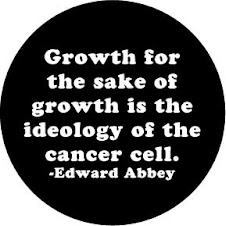You can download the latest episode at The Alternative Kitchen Garden website, listen to it in the audio player here or just read the transcript of our bit below, but it would be a shame to miss the AKG content.
"In the last episode we mentioned the shade structure we are planning for the south side of the house in Hickory North Carolina. Due to the intensity of the sun at that latitude we will eventually extend it to the SE and SW sides of the house as well. This structure forms a boundary between the house and the gardens.
Today’s permaculture tip is from “The Woodland Way - A Permaculture Approach to Sustainable Woodland Management” by Ben Law published by Permanent Publications in 2005.
“Wherever species, soils, elements, or natural or artificial boundaries meet, edges appear. Edges are highly productive environments. ... If we look at the edge between woodland and grassland, we find that the edge contains both species from the woodland and the grassland, as well as the species unique to the edge itself!”
This edge idea helps us to introduce the Permaculture concept of Zones.
In the book “Permaculture: A Practical Guide for a Sustainable Future”, Bill Mollison discusses 6 distinct zones. These are largely based around how much time is needed in each. For instance, a chicken coop might be visited more than 400 times in a year to gather eggs and manure, deliver water, cull, and perform maintenance whereas an oak tree may be visited only once or twice to collect acorns. Therefore it makes more sense to place the chicken coop close to the house and leave the oak tree in the woods.
Here are the zones according to Mr. Mollison, moving from the woods to the house;
Zone 5 is for the wild; unmanaged, lightly foraged and generally left alone, used for study, a place to learn the rules of the locale. This will be quite small on our 1/3 acre.
Zone 4 will be even smaller, it borders on the wildest areas and typically contains pasture and larger ponds, which we will not have room for, and minimally managed trees and shrubs for foraging and fuel.
Zone 3 is more for commercial use; livestock (only chickens for us) and crops for sale, natural or minimally pruned trees, storage and animal barns, water storage, vegetative windbreaks and habitat.
Zone 2 is less intensively managed with small ponds and hedges, home orchards and kitchen crop beds.
In Zone 1 are areas needing more frequent interaction; kitchen herb gardens, chicken laying coops, seedling propagation areas, rainwater tanks, small quiet livestock, and household waste recycling areas. To quote Mr. Mollison “In this zone, we arrange nature to serve our needs.”
Zone 0 is the dwelling and it’s attached structures, including potted and trellised plants and associated animals.
As our most urgent need is to get zone 0 prepared for occupancy, we must first consider how our structure interacts with the surrounding environment. The shade structure forms the interface with the surrounding environment.
In our design we’ve referred to The following principles from a Toby Hemenway slideshow at the Natural Building Convergence in May of 2002, it is available at the “I love cob” podcast archive at ilovecob.com/. The author of “Gaia’s Garden; A guide to home scale permaculture” Mr. Hemenway discussed the concept of “The Unified Landscape”.
#1 How can inhabiting the site be a net gain for the environment?
#2 How can we tie buildings into the site aesthetically and functionally?
#3 How can a building heal its own damage to the site, as well as past damage?
These principles take into account the effects of construction including materials production; be it mining, logging or petrochemical manufacturing, transporting those materials, as well as detrimental effects of construction; such as soil compaction, erosion, and habitat degradation.
Subsequent to construction there are the effects of inhabiting a site; energy and resource use, waste issues, and the long term effects of the structure such as impermeable surfaces and daylighting changes.
Hopefully while minimizing these negative effects we can compensate by capitalizing on opportunities created by the site; such as onsite resource collection, use and recycling, as well as creation of microclimates and increasing edges, thus achieving greater biodiversity. And lastly, by taking over the site we hope to increase human stewardship compared to its current use.
Our shade structure, with integrated conservatory and solar panels, and the added terrace it is built upon will be instrumental in accomplishing many of these goals as it will drastically improve the passive solar performance of the existing house and will generate electricity for various activities around the site. The conservatory will not only heat the house in the winter but will provide a platform for seedling propagation and growing of tropical plants like bananas. The timber frame shade structure will provide vertical growing space, as well as the beginnings of an integrated rainwater management system. We’ll discuss rainwater harvesting in the next episode.
And that’s it for this episode. Thanks for listening and until next time visit us at sustliving.blogspot.com. We’ll leave you with a quote from Gary Paul Nabhan “ One permaculture application does not necessarily make a long-term solution; it generates new challenges in an ever-evolving setting. Our role is to participate in ecological succession, not to freeze the landscape.”
What have you done today to lower your impact?
We are washing away the foundations of our existence on every front. It is high time we move from crashing about on the planet like a bull in china shop and find a way to go forward with intent. We must find systems of living based on sustainability. The systems and tools exist, it is up to each of us to adopt them.
Blog Archive
-
▼
2010
(159)
-
▼
March
(26)
- Video - Almost Level, West Virginia
- Video - Sandar Postel: Are Americans Facing Realit...
- Jamie Oliver's Food revolution, a message from TED
- David Holmgren on the Endurance of Suburbia
- Stinging Nettle, my favorite spring green
- Retrofitting with Justice: Clean Energy Works Port...
- Growth? We need it but not the kind you think.
- Farmers Speak: Bust Up Big Ag
- Living off the land. It is a pretty sweet life.
- Post Carbon Exchange: Richard Heinberg & Lester Brown
- Leveling Appalachia
- The next AKG podcast audio contribution.
- From The Hill -Poverty and tyranny central to immo...
- From Transition Culture - Why GM Has No Place in a...
- Coffee Party anyone?
- The power predictor
- The many problems with industrial agriculture
- Video - TED - Dan Barber's foie gras parable
- Video - Contraction and Convergence
- The Open Book of Social Innovation
- Rabbits, not just a garden menace, they are food.
- Video - Van Jones: 'Will All Americans Have A Fair...
- Monbiot, solar panels, and consumerism
- Methane
- No huge surprise, synthetic nitrogen is bad for th...
- Video - What We Know about Climate Change
-
▼
March
(26)
Subscribe to:
Post Comments (Atom)




.jpg)







No comments:
Post a Comment